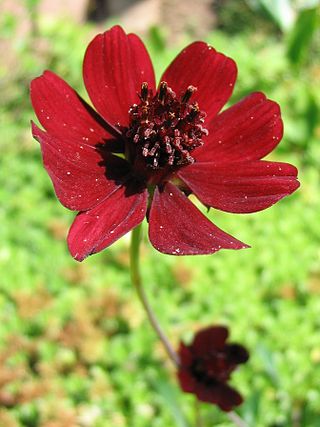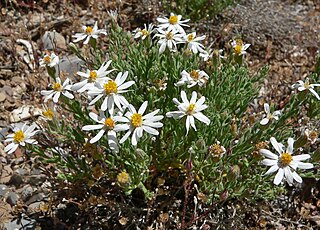
Cosmos is a genus, with the same common name of cosmos, consisting of flowering plants in the sunflower family.

Anisocoma acaulis is a wildflower found in the Mojave, Colorado Deserts, and California's Owens Valley above 2,000 feet (610 m), up to about 7000 ft.

Cosmos atrosanguineus, the chocolate cosmos, is a species of Cosmos, native to Mexico. It has often been claimed that it is extinct in the wild; however it is "quite abundant" in Mexico. The species was introduced into cultivation in 1885, when the British seed company Thompson & Morgan first listed it in their seed catalogue. Its dark red to brownish red flowers have a scent resembling chocolate, which is one reason for its popularity as a cultivated plant.

Zinnia acerosa is a low-growing perennial flowering plant native to the Southwestern United States and Northern Mexico. Common names include desert zinnia, wild zinnia, white zinnia, and spinyleaf zinnia. It is a popular landscape plant in the southwest due to its low water use and long bloom period. The flowers also serve as a food source for southwestern butterflies.

Chaenactis is a genus of plants in the family Asteraceae which are known generally as pincushions and dustymaidens.

Chaetopappa is a genus of plants in the family Asteraceae which are known generally as leastdaisies.

Cosmos caudatus or king's salad is an annual plant in the genus Cosmos, bearing purple, pink, or white ray florets. It is native to Latin America, and the West Indies, though naturalized in tropical parts of Asia, Africa, and Australia.

Acourtia microcephala is a species of flowering plant in the family Asteraceae known by the common name sacapellote. It is native to southern California and Baja California, where it grows in woodland and chaparral, especially in the coastal mountain ranges.

The Comisión Nacional para el Conocimiento y Uso de la Biodiversidad is a permanent inter-ministerial commission of the Federal Mexican government, created in 1992. It has the primary purpose of coordinating, supporting and executing activities and projects designed to foment understanding of biodiversity within Mexico and the surrounding region. As a governmental agency, CONABIO produces and collates biodiversity data and assessments across Mexico's varied ecosystems. It also either administers or guides a range of biological conservation and sustainability projects with the intention of securing benefits to Mexican society as a whole.
Geissolepis is a genus of flowering plants in the family Asteraceae.
Pippenalia is a genus of Mexican plants in the groundsel tribe within the sunflower family.
Clappia suaedifolia is the sole species in the North American genus of flowering plants in the family Asteraceae, Clappia.

Yucca lacandonica is a plant species in the yucca genus with the common name "tropical yucca." It is native to Belize and to southern Mexico, the states of Chiapas, Veracruz, Tabasco, Quintana Roo, Campeche, and Yucatán. It is uniquely the only epiphytic species in the genus, although it has been reported to grow terrestrially as well.

Cosmos parviflorus, also known as southwestern cosmos, is a species of plant in the family Asteraceae found in North America. In many places it is a common weed in agricultural fields, although it also grows in grassy meadows in forested areas. The species appears to be native in Texas, New Mexico, Colorado, Arizona, and Utah. Collections have also been made from Massachusetts, Maine, Maryland, Missouri, Rhode Island, although it appears to be introduced to those regions. It is widespread in Mexico from Chihuahua to Oaxaca.

Cirsium texanum is a species of plants in the tribe Cardueae within the family Asteraceae found in North America. Common names include Texas thistle, Texas purple thistle or southern thistle. The species is native to northern Mexico and the southern Great Plains of the south-central United States.
Cosmos pacificus is a Mexican species of plants in the family Asteraceae. It is native to southwestern and west-central Mexico from Sinaloa to Chiapas.
Cosmos ochroleucoflorus is a Mexican species of plants in the family Asteraceae. It has been found only in the state of Durango in northwestern Mexico.
Cosmos longipetiolatus is a Mexican species of plants in the family Asteraceae. It has been found only in the state of Jalisco in southern Mexico.
Tagetes foetidissima is a Mesoamerican species of marigolds in the family Asteraceae. It is widespread across much of Mexico and Central America from Tamaulipas to Costa Rica. Common name is "flor de muerto," Spanish for "death flower."
José Sarukhán Kermez is a plant biologist and ecologist. He is currently the National Coordinator for Mexico’s National Commission for Knowledge and Use of Biodiversity (CONABIO). He received a B.A. from National Autonomous University of Mexico (UNAM) in 1964, a Masters from Postgraduate College (Chapingo), and a Ph.D. (Ecology) from the University of Wales. A known expert in the biodiversity of Mexico, Sarukhán’s main interests include tropical ecology, plant population ecology, and the systems ecology of both temperate and tropical ecosystems, as well as training and education. He has published over 110 research papers and authored and co-authored several books.











